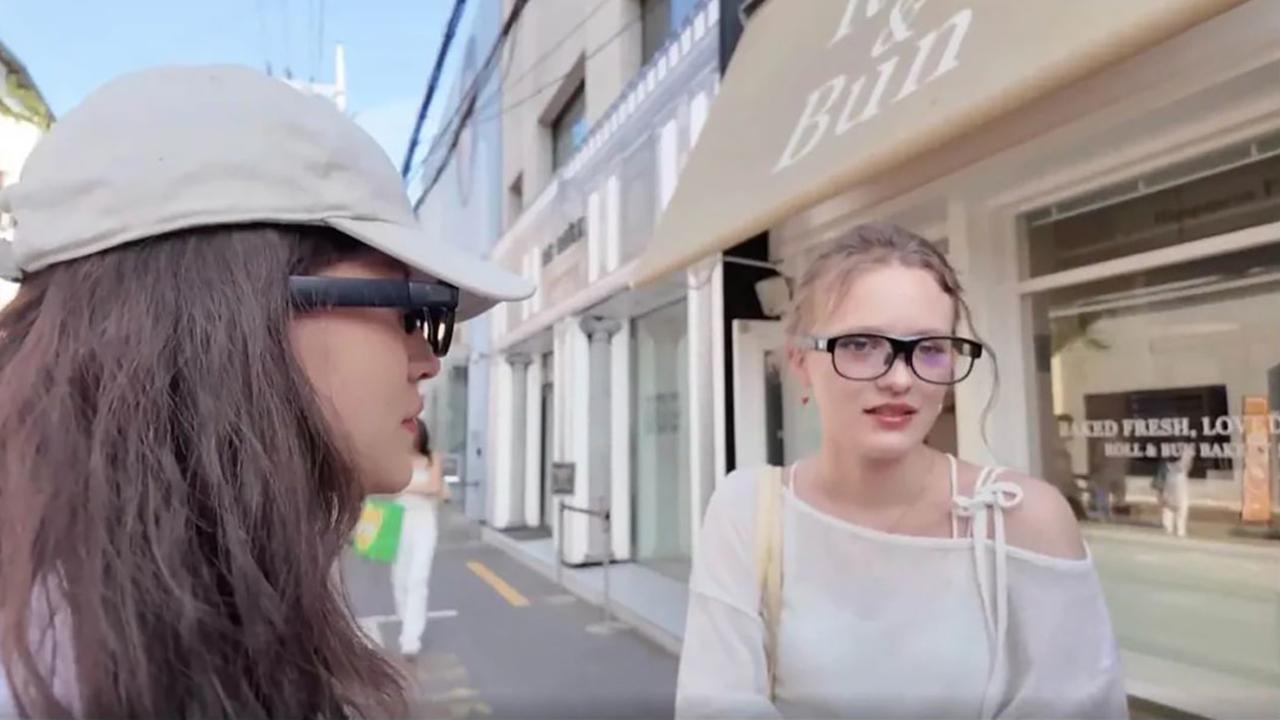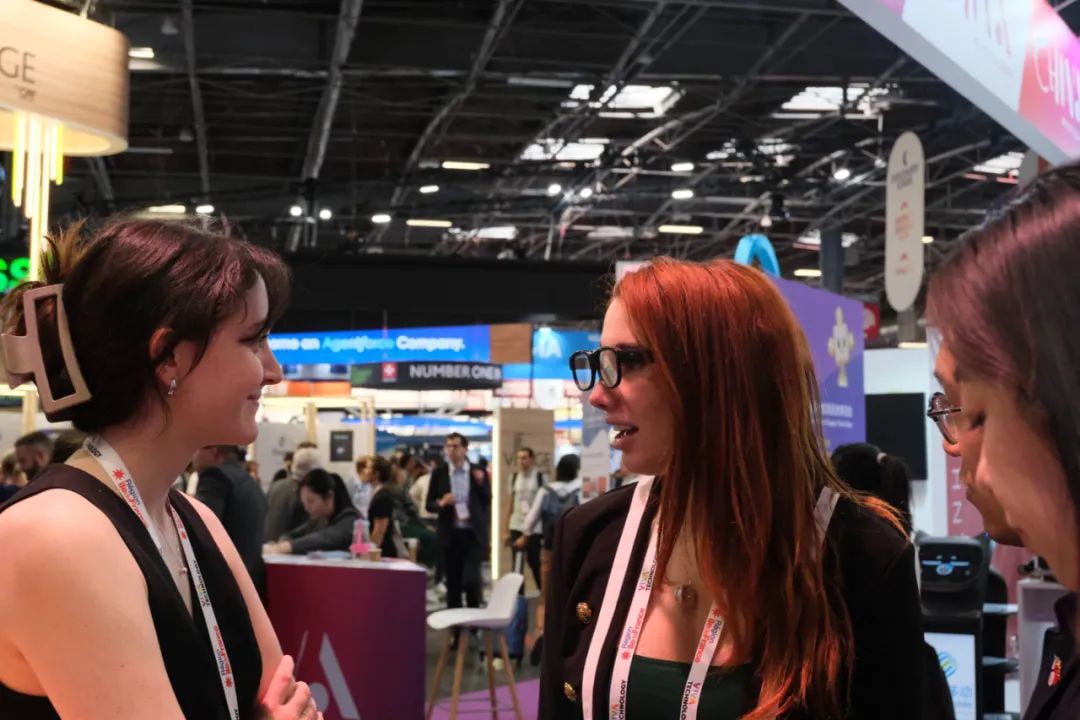Whether you’re strolling through Causeway Bay in Hong Kong, navigating the dense Shibuya ward of Tokyo, or walking along East Nanjing Road in Shanghai, each location offers a distinct soundscape shaped by the local languages that fill the air. But only the languages we understand serve as bridges for communication. The rest remain as barriers.
Even today, language continues to be a major hurdle in global business and cultural exchange. Although technology has advanced, ushering in translation devices and smart pens, these tools have drawn criticism online. Complaints often cite low accuracy, delayed responses, and a lack of real-time capabilities.
By contrast, smart glasses powered by artificial intelligence are starting to shift that narrative. With augmented reality (AR) displays, these glasses integrate voice and text recognition with AI-based translation to project content directly onto the lens, enabling real-time cross-language communication.
At a recent event in South Korea, Beijing-based AR firm LLVision introduced its Leion Hey2 smart glasses. Founder and CEO Wu Fei delivered a speech in Mandarin using the glasses’ teleprompter function. Meanwhile, over 100 attendees tested the glasses’ real-time translation feature during the two-hour event.

Just a few years ago, such fluid interaction across languages was harder to imagine. Conversations were frequently interrupted by translation delays. With these new devices, multilingual communication is becoming more seamless.
Consumers, too, are showing greater interest in glasses that offer built-in, real-time translation.
AR’s trilemma
Translation is now a baseline feature in most consumer-grade smart glasses. However, it significantly strains battery life. A practical target is six hours of continuous use and a standby time of up to a week, but few devices reach that mark.
This reflects a well-known trilemma in AR hardware: no product has yet succeeded in maximizing performance, minimizing weight, and sustaining long battery life all at once. Tradeoffs are inevitable.
Most consumer-grade smart glasses last just two to four hours on a charge, suitable only for short bursts of use. Some brands have introduced external battery packs or modular charging components, but these add weight and compromise comfort.
Other persistent issues include distorted visuals, bulky designs, and awkward aesthetics. Rainbow artifacts, which appear like ripples on glass, disrupt the viewing experience. Many models still look conspicuously high-tech, deterring users who prefer glasses that blend in. Although newer designs are slimmer, many remain too heavy for prolonged wear.
LLVision claims it has addressed these problems with the Leion Hey2.
“We focused squarely on translation as the core function,” Wu told 36Kr. “We eliminated redundant features unrelated to translation to reduce power draw. We also developed a proprietary operating system that dramatically lowers overall power consumption and deeply optimizes the translation and voice processing stack at the system level.”
The Hey2 includes multiple microphones arranged to provide 360-degree spatial audio awareness. This enables the glasses to detect a speaker’s location with high precision and isolate their voice from background noise.
“This is critical in noisy environments,” Wu said. “It helps isolate the voice you want to hear from background noise, making the translation both faster and more accurate.”
According to 36Kr, the Leion Hey2 maintains 98% voice recognition accuracy even when ambient noise is six decibels louder than the speaker. It supports real-time translation in over 100 languages, with latency under 500 milliseconds, near the threshold at which humans perceive a response as instantaneous. Users see translated subtitles almost in sync with speech. The device also supports sentence segmentation and voice recognition during transcription.
Battery life has seen major improvements. The Hey2 offers over eight hours of continuous use, with a charging case that extends total uptime to 96 hours, several times longer than comparable products.
The glasses use a single-projector, dual-eye diffractive waveguide with micro LED technology, delivering peak brightness of 2,500 nits. This makes on-screen text visible even in direct sunlight, addressing a long-standing limitation of AR displays.
Its optical system also minimizes glare, reduces rainbow artifacts, and prevents light leakage from the lens, resulting in a cleaner and more immersive viewing experience.
On the manufacturing side, LLVision has increased the yield rate of its diffractive waveguide modules to 98% using advanced optical techniques. Compared to other designs like Birdbath or freeform optics, LLVision’s lenses are lighter, thinner, and more transparent.
The entire unit weighs 49 grams and closely resembles a standard pair of sunglasses. In theory, users can expect immersive translation with minimal awareness of wearing a device.
Additional features include a voice assistant called “Hey Agent,” tools for reminders, meeting transcripts, AR navigation, and teleprompter capabilities.

Designed for the real world
The Leion Hey2 marks a significant leap from its predecessor, offering a more refined design, lighter build, and brighter display. It also reflects LLVision’s years of accumulated technical experience.
LLVision has operated in the AR and AI space for over a decade. Since 2014, it has been developing geometric array waveguides, which entered mass production in 2018. The company has long supplied AR solutions to clients in sectors such as manufacturing, energy, aerospace, and logistics, and it has led China’s enterprise AR shipments for several years.
In 2022, LLVision entered the consumer market, adapting enterprise technology for everyday users. Its first product, the Leion Hey, sold more than 30,000 units. On average, users spent 150 minutes per day using the device, suggesting it served more than a niche need. It became especially useful to travelers and people with hearing impairments who needed a visual aid for spoken language.
The Leion Hey2 took three years to develop. Wu said the company deliberately focused on perfecting a single use case: translation.
“Translation might seem like a simple feature, but it’s incredibly demanding in different real-world scenarios,” he said. “We’d rather make one product that scores 95 out of 100 than several that score 70.”
Translation involves more than converting language. Timing and conversational flow are critical to preserving the natural rhythm of speech.
Smart glasses like the Leion Hey2 are redefining the possibilities. In a Tokyo restaurant, users can read subtitles while their server speaks. In a noisy Seoul subway, the glasses can zero in on a specific voice. At a tech expo in Munich, an engineer can hold a live conversation across languages, complete with real-time technical references.
And despite its expanded capabilities, the Leion Hey2 is priced over 60% lower than the high-end version of its predecessor, thanks to supply chain advances in China.
Improved domestic production, especially for components like system-on-chip (SoC) circuits and flexible boards, has cut AR manufacturing costs by more than 30%, boosting consistency and reliability.
Riding this momentum, LLVision is expanding into North America, Europe, and Southeast Asia.
Over the past two years, the AR device sector has entered a new phase of competition. Established players are consolidating their leads while new entrants are pushing forward with innovations in design, software, and core features.
According to iResearch, AR glasses shipments in China are projected to reach 286,000 units in 2024. Advances in waveguide optics and large AI models are steering the industry toward lighter, more functional, and socially integrated products.
A report by Huajin Securities estimates that shipments of smart audio glasses could exceed five million units in 2025 and reach 9.5 million by 2030. These devices, which prioritize audio but may incorporate AR features, could soon compete directly with today’s true wireless stereo earbuds.
Subtitle-enabled smart glasses are just one slice of this broader market, but a standout one. With continued adoption, their “iPhone moment” may not be far off.
KrASIA Connection features translated and adapted content that was originally published by 36Kr. This article was written by Xiao Xi for 36Kr.
